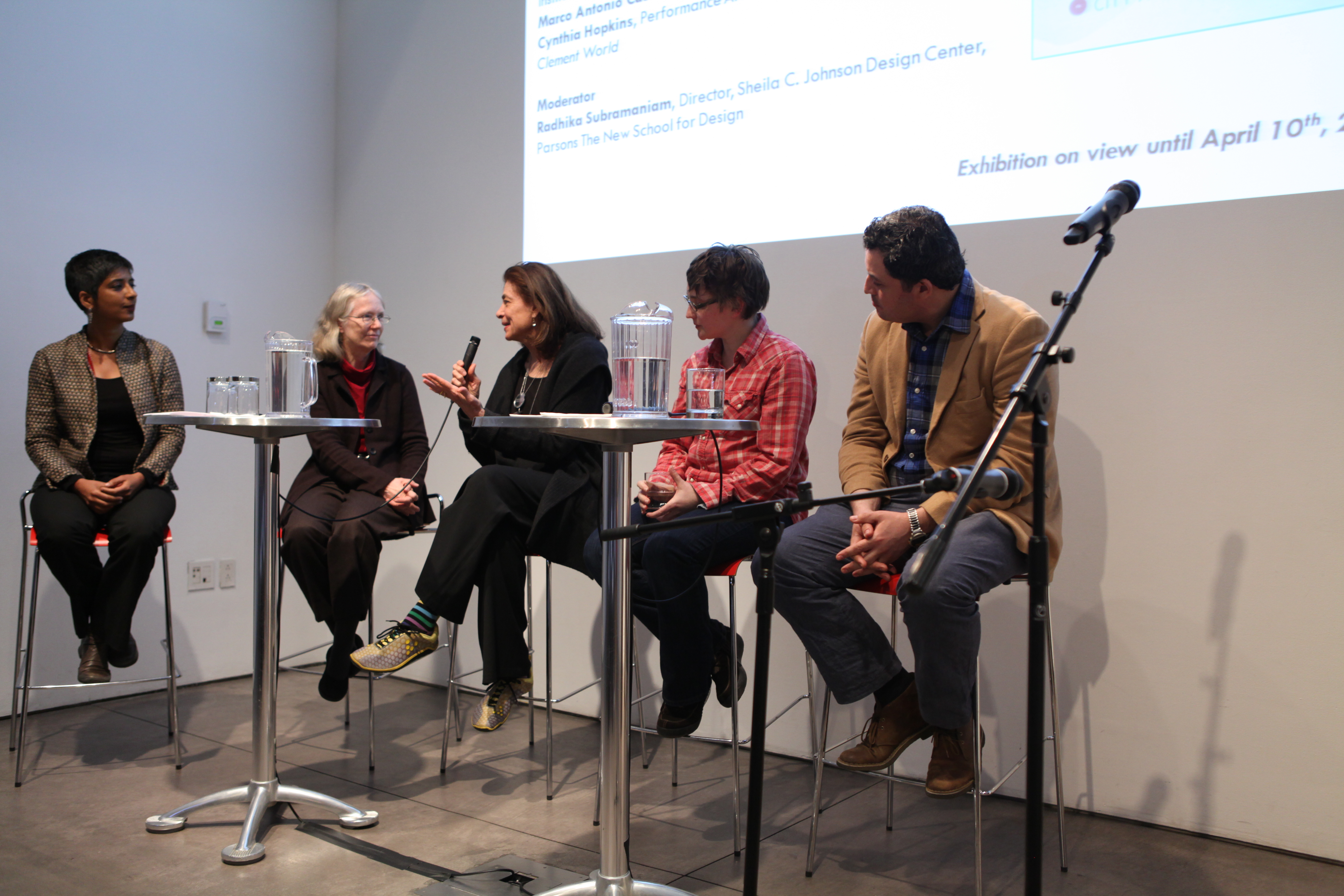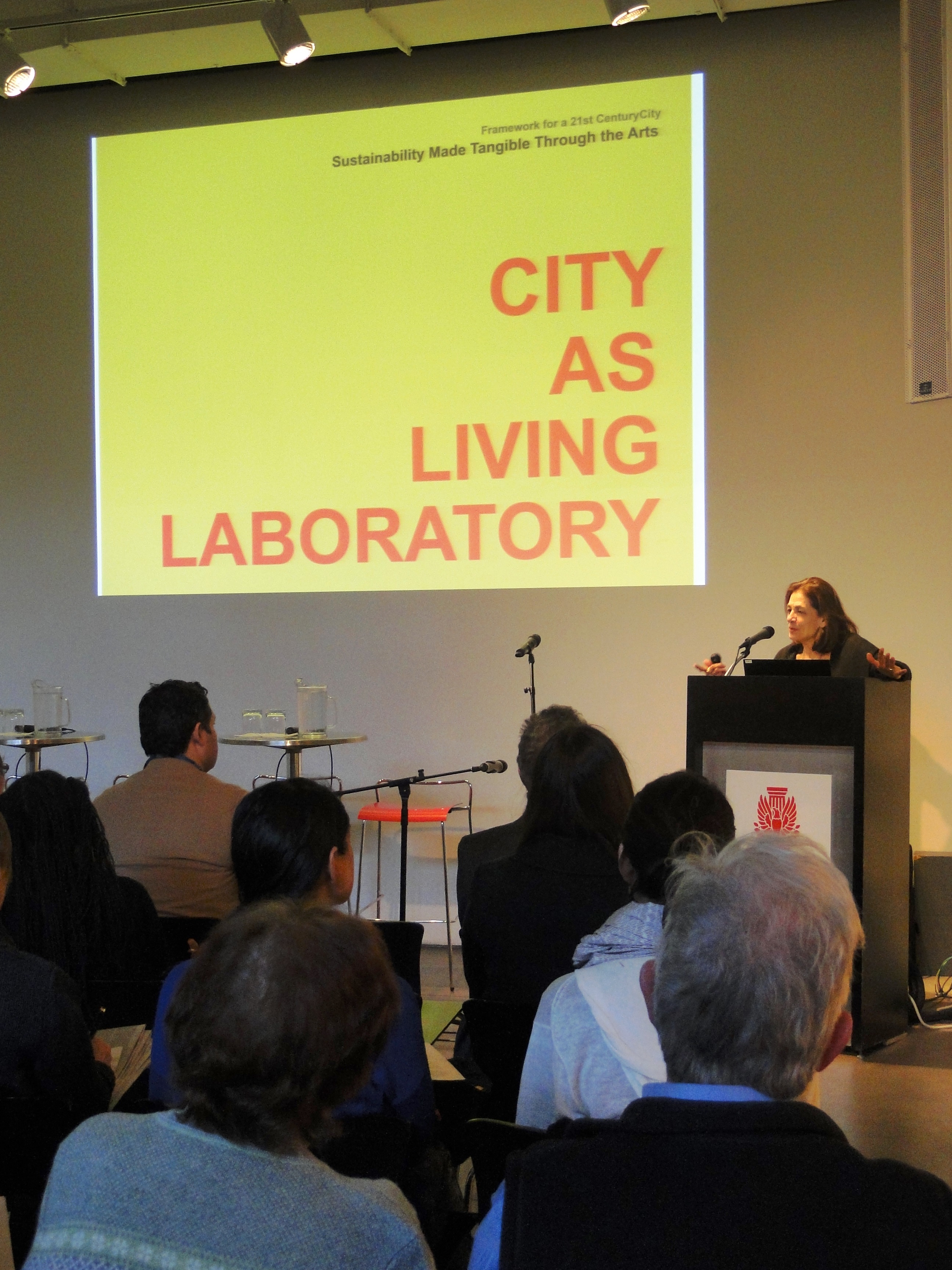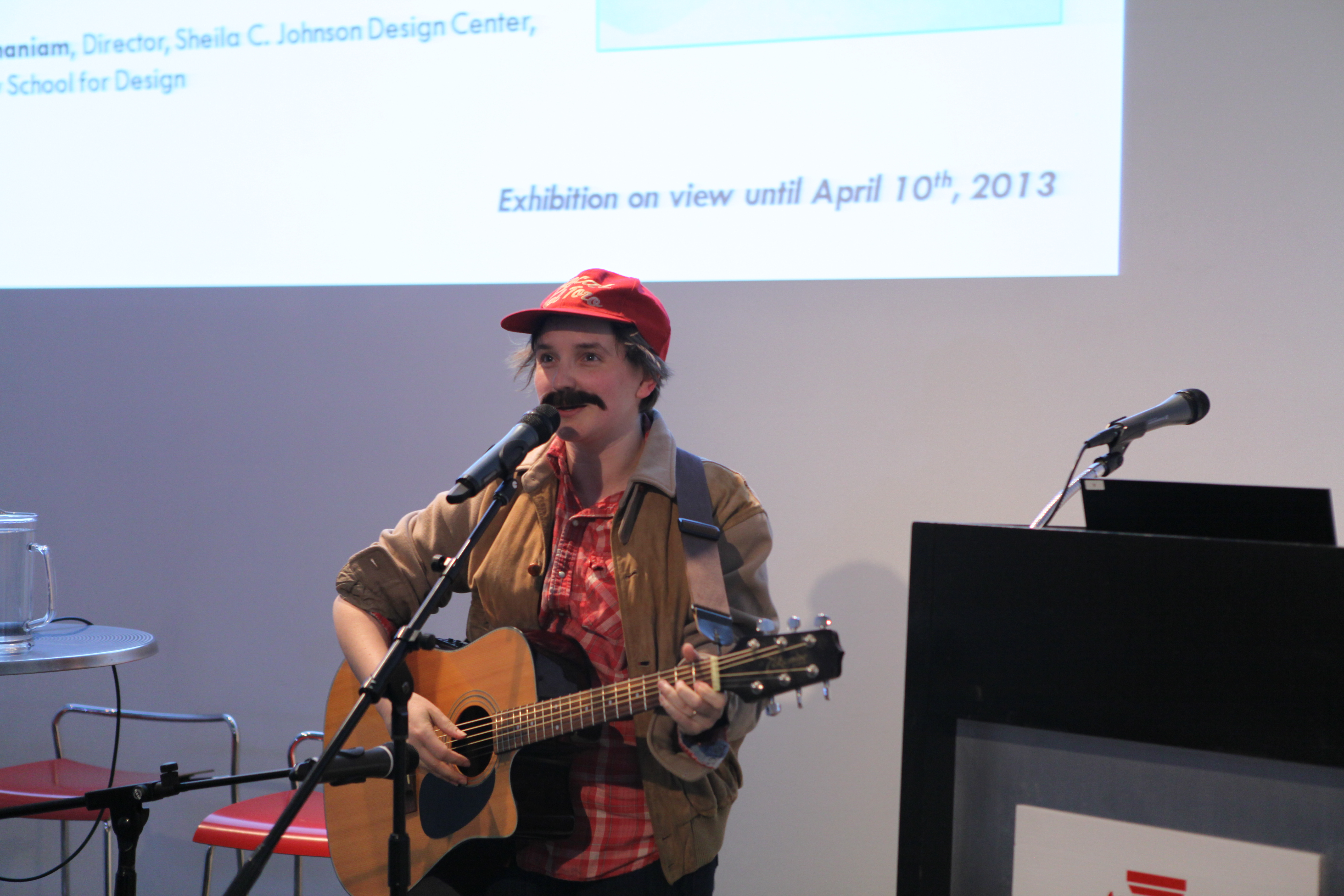by Bill Millard
Interdisciplinary exchange is a natural way of working among architects and allied design professionals, but in many realms it represents more of an ideal than a reality. Addressing the broad question of how artists and scientists can join forces to enhance public awareness of environmental imperatives, a panel representing the visual and performing arts, climate science, and interactive media design drew attention to the practical challenges as well as the possibilities. The exhibition “Broadway: 1000 Steps” by Mary Miss/City as Living Laboratory, which was recently on view in the Center for Architecture’s Margaret Helfand Gallery, offered credible visions of how art and design can transform Manhattan’s most fabled avenue into a “green corridor” of informative, colorful street-level projects organized in up to 20 hubs along its 14 miles. This and related efforts, both realized and hypothetical, allowed the panelists to anchor their discussions in specific test cases.
With extensive experience in site-specific interventions in New York, Boulder, Indianapolis, New Delhi, Beijing, and other cities, Miss speaks authoritatively about artists’ struggles to overcome a perceived marginal role in relation to civic officials, scientists, and other assorted public-space stakeholders, repeatedly proving that “artists have a real role, an essential role, that we’re not the icing on the cake.”
She has identified and frequently overcomes obstructive assumptions: that the array of required approvals, though they have legitimate and plausible rationales from municipal officials’ perspective, makes New York an impossible place to work; that “everything is about ‘No.’” After looking at Long Island City last year as one of four artists working with the Noguchi Museum and the Socrates Sculpture Park on “Civic Action,” a neighborhood-wide cultural revitalization effort, and now proposing to transform Broadway gradually into a “research district for artists,” Miss has the chance to reach the general public with information and forms of expression that make aspects of sustainability tangible. The designation of a specific district answers artists’ and other social communicators’ recurrent problems of permission and access, creating a safe and expedited spatial realm for new ideas (much as the upcoming “Ideas City” festival [in which AIANY is participating] strives for similar effects during a particular time).
Hurricane Katrina, she observed, for a variety of reasons, was a missed opportunity. New York, in contrast to New Orleans, has a foundational community of environmental scientists who have been doing pioneering work on climate change and predicting storm impacts in advance for well over a decade, plus a fortuitous alignment of municipal, state, and federal leaders aware of the problems. Superstorm Sandy revealed vulnerabilities here, catching utilities particularly unprepared, but also created the opportunity for communicators like Miss to go into action and create a different tipping point in response, one involving perception and action. “We as New Yorkers,” she concluded, “can’t let people forget.”
Artistic expressions with serious educational intent can be hard sells to a public drenched in light entertainment and often heavily armored against anything didactic, achingly sincere, or guilt-inducing. As Miss noted, finding ways to “engage people without shaming them” is a critical strategy in bringing green-oriented art to a consumer society, unless one wants to preach exclusively to the choir. A balance of provocation and playfulness, emphasized respectively by storyteller/musician Cynthia Hopkins and interactive designer Marco Antonio Castro Cosio, appears effective. Hopkins weaves personal and societal concerns into thought-tapestries of song, character, and complex narrative frameworks. Her multimedia work “This Clement World” is inspired by Lamont-Doherty climatologist Wallace Broecker’s talk at the Columbia Earth Institute’s Tipping Point conference, and by an Arctic sea journey she took as part of the Cape Farewell project.
The song she presented at the panel, “Another Hundred Years” – delivered in character by a mustachioed “fairly amiable dude” who turns out to be an extraterrestrial – began with a comparison between humanity’s fossil-fuel addiction and Hopkins’s own struggles with substance abuse and recovery, only to pull the about-face assessment that “the metaphor don’t work” (an individual alcoholic can hit bottom and get clean, whereas humanity will have no collective rehab option if it doesn’t wise up about its energy use before bringing on irreparable planetary damage). The song then shifts its tone toward plaintive, guarded optimism about the chance to live in a non-cataclysmic future. It’s quite a set of frames, perspectives, and ironies to take in, deservedly termed “postmodernist” in the nonarchitectural sense. Her aching melodies help drive it home.
Hopkins’s layered messages contrast in reciprocally refreshing ways with Castro’s efforts to capture all ages’ attention through improbable placements of sedum patches, vines (a “green cloak”), and other forms of foliage, working with a host of organizations (Architecture for Humanity, No Longer Empty, the Flux Factory art collective, Pratt’s Design Incubator, the BiomimicryNYC consortium, and others) to green-up everything from bus roofs and inner tubes, to the University of Maryland’s pickup-truck flatbeds and the Biomodd electronic/biologic project, which integrates algae growth with video-game performance.
Castro is as wildly prolific as his plants, and his enthusiasm emphasizes an essential principle: even when it’s deadly serious, art always operates in the realm of homo ludens, the human being at play. Audience responses included a plea for environmental artists to steer clear of capital-P politics and “stay in the street, stay with the kids.” While AIANY Executive Director Rick Bell, FAIA, noted that a small-p political dimension (defined as “decision-making about what is possible,” not ideology) is usually a part of these artistic engagements, the panel’s energetic discussion proved that there is no inherent disjuncture between people thinking hard about matters of gravity and people whose imaginations are exuberantly at play.
Event: Broadway: 1000 Steps: Artist-Scientist Partnerships to Make Sustainability Visible Through the Arts
Location: Center for Architecture, 04.03.2013
Speakers: Radhika Subramaniam, Director, Sheila C. Johnson Design Center, Parsons The New School for Design (moderator); Mary Miss, Artist and Artistic Director, Mary Miss/City as Living Laboratory; Cynthia Hopkins, Performance Artist and Musician, Creator of This Clement World; Dr. Cynthia Rosenzweig, Senior Research Scientist, NASA Goddard Institute for Space Studies, Director of the Climate Impacts Group; Marco Antonio Castro Cosio, Artist and Interactive Media Designer
Sponsors: A.G. Foundation, Dorothy Lichtenstein (Major Funders); BRB Architects-Tom Bishop, Marlon Blackwell, Lynn Burditt, FXFOWLE, The Peter T. Joseph Foundation, Pennsylvania State University, Pratt Institute, Tsao & McKown Architects (Sponsors): Robert Baron, H. Campbell and Eleanor Stuckeman, Fabrication Specialities, Ray Gastil, Joseph Giovannini, Carol Lewitt, Senior & Shopmaker Gallery, Weiss/Manfredi Architects (Donors), and multiple individual contributors (see http://cfa.aiany.org/index.php?section=exhibitions&expid=250)


